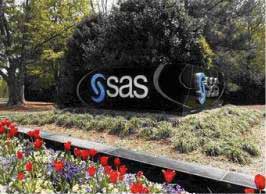This is “Individual Attitudes and Behaviors”, chapter 4 from the book An Introduction to Organizational Behavior (v. 1.0). For details on it (including licensing), click here.
For more information on the source of this book, or why it is available for free, please see the project's home page. You can browse or download additional books there. To download a .zip file containing this book to use offline, simply click here.
Chapter 4 Individual Attitudes and Behaviors
Learning Objectives
After reading this chapter, you should be able to do the following:
- Identify the major work attitudes that affect work behaviors.
- List the key set of behaviors that matter for organizational performance.
- Understand the link between work attitudes and ethics.
- Understand cross-cultural differences in job attitudes and behaviors at work.
People Come First at SAS Institute
Figure 4.1

The SAS institute is a leader in the art of treating employees well.
© 2008. SAS Institute Inc. All rights reserved. Reproduced with permission of SAS Institute Inc., Cary, North Carolina.
Who are your best customers? Which customers are bringing you the most profits and which are the least profitable? Companies are increasingly relying on complicated data mining software to answer these and other questions. More than 90% of the top 100 companies on the Fortune Global 500 list are using software developed by SAS Institute Inc. for their business intelligence and analytics needs. The Cary, North Carolina, company is doing extremely well by any measure. They are the biggest privately owned software company in the world. They have over 10,000 employees worldwide, operate in over 100 countries, and reported $2.15 billion in revenue in 2007 (their 31st consecutive year of growth and profitability). The company is quick to attribute their success to the performance and loyalty of its workforce. This is directly correlated with how they treat their employees.
SAS has perfected the art of employee management. It has been ranked on Fortune Magazine’s best places to work list every year since the list was first published. Employees seem to genuinely enjoy working at SAS and are unusually attached to the company, resulting in a turnover rate that is less than 5% in an industry where 20% is the norm. In fact, when Google designed its own legendary campus in California, they visited the SAS campus to get ideas.
One thing SAS does well is giving its employees opportunities to work on interesting and challenging projects. The software developers have the opportunity to create cutting-edge software to be used around the world. The company makes an effort to concentrate its business in the areas of analytics, which add the most value and help organizations best analyze disparate data for decision making, creating opportunities for SAS workers to be challenged. Plus, the company removes obstacles for employees. Equipment, policies, rules, and meetings that could impede productivity are eliminated.
The company has a reputation as a pioneer when it comes to the perks it offers employees, but these perks are not given with a mentality of “offer everything but the kitchen sink.” There is careful thinking and planning behind the choice of perks the company offers. SAS conducts regular employee satisfaction surveys, and any future benefits and perks offered are planned in response to the results. The company wants to eliminate stressors and dissatisfiers from people’s lives. To keep employees healthy and fit, there are athletic fields, a full gym and swimming pool, and tennis, basketball, and racquetball courts on campus. Plus, the company offers free onsite health care for employees and covered dependents at their fully staffed primary medical care center, and unlimited sick leave. The company understands that employees have a life and encourages employees to work reasonable hours and then go home to their families. In fact, a famous motto in the company is, “If you are working for more than 8 hours, you are just adding bugs.” SAS is truly one of the industry leaders in leveraging its treatment of people for continued business success.
Sources: Based on information from Anonymous. (2007, December 1). Doing well by being rather nice. Economist, 385(8557), 84; Cakebread, C. (2005, July). SAS…not SOS. Benefits Canada, 29(7), 18; Florida, R., & Goodnight, J. (2005, July–August). Managing for creativity. Harvard Business Review, 83(7/8), 124–131; Karlgaard, R. (2006, October 16). Who wants to be public? Forbes Asia, 2(17), 22.




